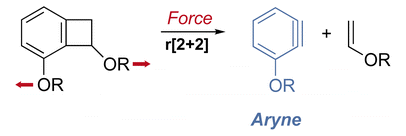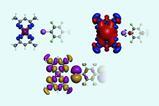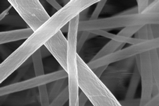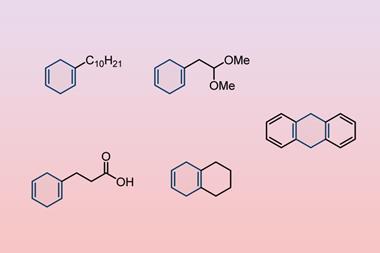A reactive aryne intermediate can be created by mechanically pulling apart a substituted benzocyclobutene molecule, new research shows.1 ‘This is a first for mechanochemistry, being able to generate this aryne, and what’s really exciting is that the reactivity we observe is completely different from the thermal reactivity,’ explains Guillaume De Bo, who led the work alongside Qianqian Cheng at the University of Manchester, UK.
Arynes’ heavily strained triple bond makes them extremely reactive species. It also makes them useful precursors in organic synthesis as they readily participate in reactions such as nucleophilic addition and cycloaddition.
Synthesising arynes can be problematic because such reactions often require activated precursors, high temperatures or a strong base. The process developed by Cheng and De Bo, however, works under mild conditions. It makes use of molecules, called mechanophores, which change structure or undergo a chemical reaction when subjected to mechanical force.
Jeffrey Moore and colleagues at the University of Illinois in the US introduced benzocyclobutene as a mechanophore in 2007.2 They installed benzocyclobutene within a polymer strand via anchor points on its butene ring and showed that exposing the strands to ultrasound pulled those points apart to produce the same product as if it had been heated.
‘What we did is decided to stretch [benzocyclobutene] in a different direction,’ says De Bo. Moving the anchor points to instead sit either side of the ring junction between the cyclobutene and phenyl units meant that ultrasonication initiated a formal retro-[2+2] cycloaddition – rather than symmetrical electrocyclic ring opening – to form a reactive aryne intermediate and an enol ester.

‘Aryne is a highly reactive intermediate, so it is surprising that it can be generated mechanochemically,’ comments Hajime Ito, a mechanochemist at Hokkaido University in Japan. ‘The merit of this research is that it has produced intermediates that are more useful in organic reaction design, such as arynes. This is expected to stimulate research into generating other interesting reaction intermediates.’
In addition to organic synthesis, the mechanochemically generated aryne could have other applications. Ito mentions ‘sensor materials for mechanical stimulation’. Whereas De Bo suggests self-repairing or self-reinforcing polymer materials: ‘You could activate this [embedded] species and the super reactive aryne could react with any nucleophile that could be dangling in the neighbouring chain [to provide] a crosslinking mechanism in a damaged material.’
Last year, De Bo’s group reported a mechanophore with a release mechanism.3 Because the benzocyclobutene mechanophore must be within a polymer chain for activation, its practical use to generate aryne for organic synthesis is currently limited. However, if a similar release mechanism could liberate the aryne intermediate, it would open the door to many possible uses.
References
1 Q Cheng and G De Bo, Chem. Sci., 2024, 15, 13181 (DOI: 10.1039/d4sc03968h)
2 JS Moore et al, Nature, 2007, 446, 423 (DOI: 10.1038/nature05681)
3 K Suwada et al, J. Am. Chem. Soc., 2023, 145, 20782 (DOI: 10.1021/jacs.3c08771)

















No comments yet